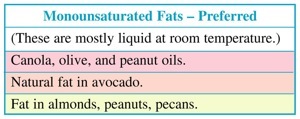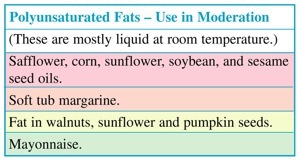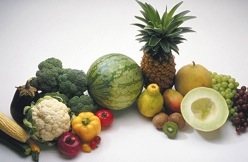-
Staying Well


Eat for Good Health
Use My Pyramid - Steps to a Healthier You
Use My Pyramid – Steps to a Healthier You. To find out about this, call 888.7.PYRAMID (779.7264) or go to www.mypyramid.gov. In the “MyPyramid Plan” box, fill in your age, sex, and physical activity level. At this site you will learn:
-
•How many calories you should eat each day.
-
•How much to eat from basic food groups, subgroups, and oils to meet your calorie needs. Serving sizes are given in cups, 1/2 cups, etc.
-
•How to keep track of the foods and beverages you eat and drink and the activities you do. You can print out copies of “MyPyramid Worksheet” to compare your choices to your “MyPyramid” plan.
-
•Tips for physical activity, eating out, a sample menu, and more.



Eat more servings of fruits and vegetables a day.
Healthy Eating Tips
-
•Choose whole-grain products and fruits and vegetables daily. These give vitamins and minerals, fiber, and other substances that are important for good health. Have 20 to 35 grams of dietary fiber per day.
-
•Choose fats wisely. Keep intakes of saturated and trans fats very low. How do you do this?
-
-Limit animal fats. This means meat fat and full-fat dairy products.
-
-Strictly limit trans fats which come from hydrogenated oils. These are in stick margarine, cookies, snack crackers, vegetable shortening (and foods fried in this).
Read food labels to find out the grams of saturated fat and trans fat an item has per serving.
Aim to have less than 2 grams of trans fat a day.
Use only monounsaturated and polyunsaturated fat for added fats.
-
•Reduce salt (sodium) and increase potassium. Having less than 2,300 milligrams of sodium (about 1 teaspoon of salt) per day may reduce the risk of high blood pressure. This is from all sources: Salt added in cooking and at the table; salt in processed food; and sodium that occurs naturally in foods. Read the Nutrition Facts on food labels for sodium content. Getting more potassium also helps lower blood pressure. Potassium is in many foods, such as fruits and vegetables, milk products, and meats. Processed foods add salt, but not potassium.

-
•If you drink alcoholic beverages, do so in moderation. The topic, Use Alcohol Wisely, explains this.
-
•Keep foods safe to eat. (See Food Poisoning.) Read how to avoid getting food poisoning in the Prevention area.
Another guide for healthy eating is the DASH Eating Plan. DASH stands for Dietary Approaches to Stop Hypertension.




For more information, including menus and recipes for different DASH Eating Plans, access:
www.nhlbi.nih.gov | Search for “DASH Eating Plan.”



Copyright © 2009, American Institute for Preventive Medicine. All rights reserved.